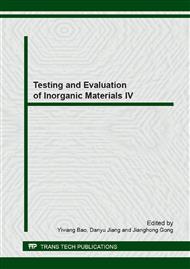[1]
Y. Cui, C.M. Lieber, Functional nanoscale electronic devices assembled using silicon nanowire building blocks. Science 291 (2001) 851-853.
DOI: 10.1126/science.291.5505.851
Google Scholar
[2]
X.F. Duan, Y. Huang, Y. Cui, et al., Indium phosphide nanowires as building blocks for nanoscale electronic and optoelectronic devices. Nature 409 (2001) 66-69.
DOI: 10.1038/35051047
Google Scholar
[3]
J.F. Wang, M.S. Gudiksen, X.F. Duan, et al., Highly polarized photoluminescence and photodetection from single indium phosphide nanowires. Science 293 (2001) 1455-1457.
DOI: 10.1126/science.1062340
Google Scholar
[4]
Y. Cui, Q.Q. Wei, H.K. Park, et al., Nanowire nanosensors for highly sensitive and selective detection of biological and chemical species. Science 293 (2001) 1289-1292.
DOI: 10.1126/science.1062711
Google Scholar
[5]
R.Q. Zhang, Y. Lifshitz, S.T. Lee, Oxide-assisted growth of semiconducting nanowires. Adv. Mater. 15 (2003) 635-640.
DOI: 10.1002/adma.200301641
Google Scholar
[6]
V. R Almeida, C.A. Barrios, R. R Panepucci, et al., All-optical control of light on a silicon chip. Nature 431 (2004) 1081-1084.
DOI: 10.1038/nature02921
Google Scholar
[7]
M.C. Kang, L. Trofin, M.O. Mota, et al., Protein capture in silica nanotube membrane 3-D microwell arrays. Anal. Chem. 77 (2005) 6243-6249.
DOI: 10.1021/ac0508907
Google Scholar
[8]
N. Wang, Y. Cai, R.Q. Zhang, Growth of nanowires. Mater. Sci. Eng. R. 60 (2008) 1-51.
Google Scholar
[9]
Z.J. Peng, X.L. Fu, N. Zhu, et al., Preparation and growth mechanism of clustered one-dimensional SiOx amorphous nanowires by catalytic pyrolysis of a polymer precursor. J. Non-Cryst. Solids. 355 (2009) 2156-2159.
DOI: 10.1016/j.jnoncrysol.2009.06.027
Google Scholar
[10]
N. Zhu, Z.J. Peng, C.B. Wang, et al., Preparation and characterization of bundled one-dimensional Si3N4 singlecrystalline. Solid. State. Sci. 11 (2009) 1094-1097.
DOI: 10.1016/j.solidstatesciences.2009.02.022
Google Scholar
[11]
J.P. Li, Z.J. Zhang, Y.M. Luo, et al., Synthesis and characterization of amorphous SiO2 nanowires derived from a polymeric precursor. J. Nanosci. Nanotechnol. 8 (2008) 997-1002.
DOI: 10.1166/jnn.2008.025
Google Scholar
[12]
Z.J. Peng, N. Zhu, X.L. Fu, et al., Growth and Mechanism of Network-Like Branched Si3N4 Nanostructures. J. Am. Ceram. 93 (2010) 2264-2267.
DOI: 10.1111/j.1551-2916.2010.03737.x
Google Scholar


